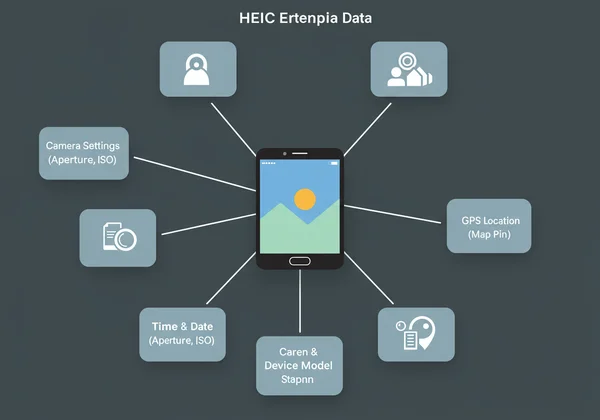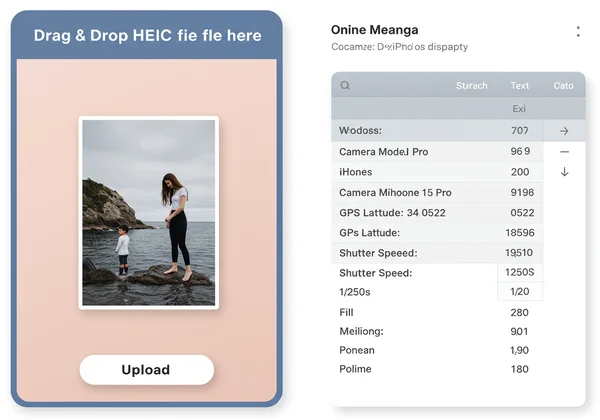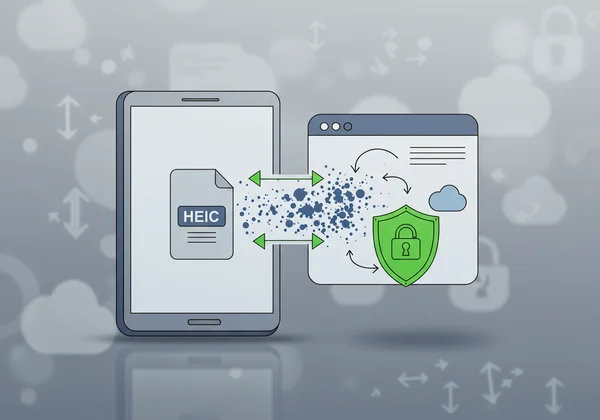Read HEIC EXIF Data: View iPhone Photo Metadata Online
Every photo you take with your iPhone tells a story, and not just through the image itself. Hidden within each HEIC file is a wealth of information known as metadata. This data can reveal everything from the camera settings you used to the precise location where the photo was taken. Unlocking this information is key to improving your photography skills and protecting your privacy. But how to read exif data from these modern image files easily and securely? The answer lies in using a powerful exif reader.
This guide will walk you through the world of iPhone photo metadata. We’ll explore what HEIC is, why its metadata matters, and how you can instantly access it using a safe, browser-based solution. With the right online exif reader, you can unveil the secrets your images hold without compromising your data.

Understanding HEIC & iPhone Photo Metadata
Since iOS 11, Apple has used HEIC (High-Efficiency Image Container) as the default format for photos. It offers superior compression to JPEG, meaning you get higher-quality images in smaller file sizes. But alongside the visual information, every HEIC file embeds extensive metadata, primarily in the EXIF (Exchangeable Image File Format) standard. This is the digital fingerprint of your photograph.
What is HEIC/HEIF and Its Metadata?
HEIC is Apple's implementation of the HEIF (High-Efficiency Image File Format) standard. Think of it as a modern container that can hold both images and their associated data. This data, or metadata, is a structured set of details automatically recorded by your iPhone when you press the shutter.
This includes:
- Camera Settings: Aperture, shutter speed, ISO, focal length, and lens information.
- Time and Date: The exact moment the photo was captured.
- Device Information: The model of the iPhone used.
- GPS Coordinates: If location services are enabled, the precise latitude and longitude are stored.
This HEIF metadata provides a complete technical background for every shot, making it an invaluable resource for photographers and anyone curious about their digital footprint.

Why iPhone HEIC Metadata Matters for You
Understanding your iPhone photo privacy is more critical than ever. The metadata embedded in your HEIC photos has significant implications for both creativity and security. For aspiring photographers, this data is a goldmine. By analyzing the settings of your best shots with an exif reader, you can replicate successful techniques and learn what makes a photo work. You can also study the work of others to understand their technical choices.
For the privacy-conscious user, the HEIC data importance is about control. When you share a photo online, you could be unknowingly broadcasting your location. A picture of your pet at home might reveal your address, while a vacation snapshot could publicize your travel patterns. Being able to check exif data allows you to make informed decisions before sharing your images on social media or public forums.
How to View HEIC EXIF Data with an Online Tool
While the data is there, iOS doesn't provide a simple, comprehensive way to view all of it. This is where a dedicated tool becomes essential. Our free exif reader is a powerful photo metadata viewer that works directly in your browser, offering a seamless way to inspect your HEIC files without any software installation.
Step-by-Step: Accessing Your iPhone's HEIC Data Instantly
Using our online tool is incredibly straightforward. You don't need any technical skills to get started. You'll find the process incredibly quick and intuitive – checking your HEIC EXIF data takes just seconds.
-
Visit the Homepage: Open your web browser on any device (Mac, Windows, or even your phone) and navigate to our online exif viewer.
-
Select Your Photo: You can either drag and drop your HEIC file directly onto the designated area on the page or click the box to open your file browser and select the image from your computer.
-
Instantly View the Data: That's it! The exif reader immediately processes the file within your browser and displays all the extracted metadata in a clean, organized report. There are no uploads and no waiting.

This simple process empowers you to become your own digital detective, uncovering the rich details behind every image you capture.
What You'll Find: Common HEIC Metadata Fields
Once you use the image exif viewer, you'll see a detailed breakdown of your photo's metadata. The report is typically divided into sections for easy reading. You can expect to find HEIC photo details such as:
- Camera Information: Make (Apple), Model (e.g., iPhone 14 Pro).
- Exposure Settings: Shutter Speed, F-Number (Aperture), and ISO Speed Ratings.
- GPS Data: If present, you'll see the latitude, longitude, and even altitude. This is the critical GPS location in HEIC files that many users want to check.
- Date and Time: Original creation date and time, down to the second.
- Image Dimensions: Pixel width and height.
By exploring this data, you gain a deeper understanding of your photography and the information you might be sharing.
The Advantage of an Online HEIF Metadata Viewer
When it comes to handling personal photos, security is paramount. Many online tools require you to upload your images to their servers for processing, creating a potential privacy risk. The best HEIF metadata viewer is one that respects your data by never taking possession of it. This is the core principle behind our online exif reader.
Instant & Secure: Browser-Side HEIC Processing
The most significant advantage of using our online exif reader is its commitment to privacy through browser-side processing. This means your HEIC files are never uploaded to a server. Because all analysis runs locally in your browser with JavaScript, your images never leave your device, completely eliminating the risk of data breaches or unauthorized access.

This approach makes it a truly secure HEIC viewer. You get the convenience of an online tool without the security compromises. It's the perfect no upload metadata tool for anyone who values their privacy, from social media managers to everyday users. You can confidently read exif data knowing your files are safe.
Beyond EXIF: IPTC & XMP in HEIC Photos
While EXIF is the most common standard for camera-generated data, professional workflows often use other metadata standards like IPTC and XMP. This online tool is more than just a basic exif reader; it provides comprehensive support for these formats as well.
- IPTC (International Press Telecommunications Council): This standard is used to add descriptive information, such as captions, keywords, creator details, and copyright information. It's essential for journalists, stock photographers, and content managers.
- XMP (Extensible Metadata Platform): Developed by Adobe, XMP is a flexible standard that can store a wide range of information, including edit history and ratings.
Our tool can display HEIC IPTC data and XMP in iPhone photos, giving professionals and enthusiasts a complete picture of an image's history and context. Give our free exif viewer a try to see for yourself.
Your Photos, Your Data: Mastering HEIC Metadata
Your iPhone photos are more than just pixels on a screen; they are rich data files packed with valuable information. Understanding and accessing this metadata empowers you to become a better photographer, a smarter social media user, and a more vigilant guardian of your personal privacy. By learning to read HEIC EXIF data, you gain full control over the story your images tell.
Don't leave your data to chance. Discover the hidden details in your iPhone photos today with a tool that is fast, free, and fundamentally secure. Visit our secure image metadata viewer to drag, drop, and discover the secrets within your images instantly.
FAQ Section: Frequently Asked Questions About HEIC & iPhone Photo Metadata
How can I view EXIF data on my iPhone photos (HEIC format)?
The easiest and most secure way is to use a tool like our browser-based exif reader. Simply transfer the HEIC photo to your computer or use your phone's browser, visit the website, and select the file. The tool will display all EXIF, IPTC, and XMP data instantly without uploading your photo. This makes it an ideal exif reader for mac and Windows alike.
Does HEIC metadata include sensitive GPS location information?
Yes, if you have Location Services enabled for your iPhone's camera app, every HEIC photo will contain precise GPS coordinates. This is one of the most critical pieces of data to be aware of before sharing photos online. You can use an image metadata viewer to check for this information.
Is it truly safe to view my HEIC photo metadata using an online tool?
It depends entirely on the tool's architecture. Our exif reader is completely safe because it performs all processing locally in your browser. Your photos are never sent to an external server, which means your privacy is 100% protected. This is the key difference that makes it a trustworthy choice to find photo location data.
Do screenshots taken on an iPhone contain EXIF data?
No, screenshots taken on an iPhone typically do not contain the rich EXIF data found in photos taken with the camera. They will have basic metadata like creation date and dimensions, but they will not include GPS location, aperture, ISO, or other camera-specific settings.
Can this tool view HEIC files from non-Apple devices or other cameras?
Yes, while HEIC is most commonly associated with iPhones, the HEIF format is an open standard. This online tool is designed to parse metadata from any standard-compliant HEIC/HEIF file, regardless of the device that created it. It also supports a wide range of other formats, including JPEG, PNG, TIFF, and WebP, making it a versatile exif data reader.